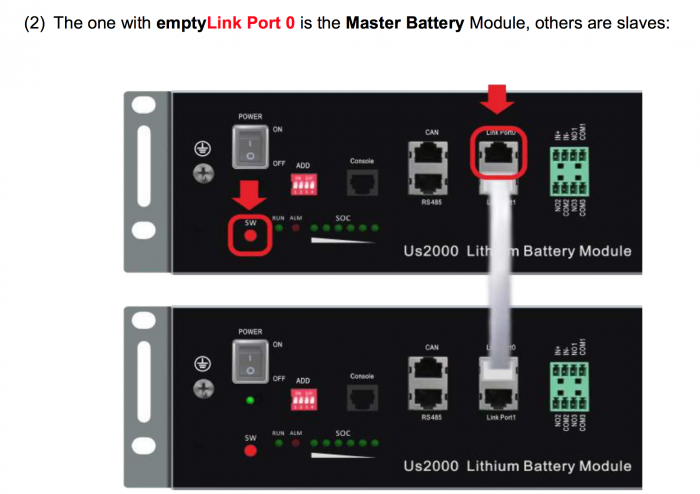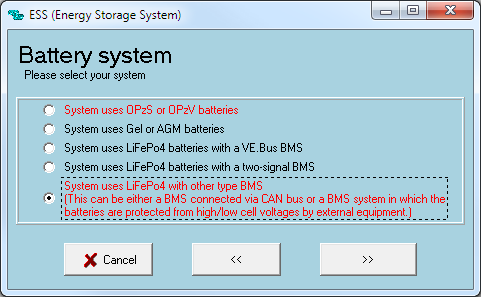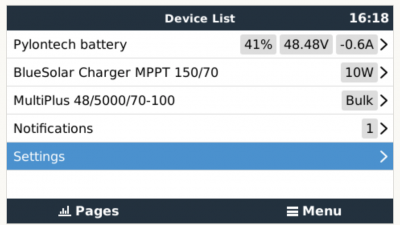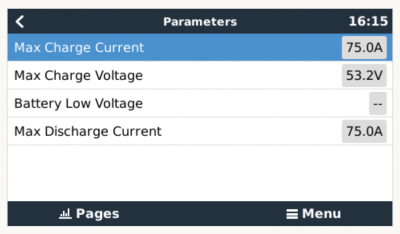This is an old revision of the document!
Table of Contents
Victron & Pylontech US2000B and Phantom-S
This manual is intended to be used in conjunction with the manual supplied by Pylontech. It provides additional and specific information regarding integration with Victron systems.
General information about the battery is found in Pylontech's documentation.
Compatible Victron products
All 48V Multis and Quattros are compatible.
Notes
- A Venus-device is necessary in the system, since that has the CANbus port which is used for the (required!) communication between the Pylontech battery and the Victron system. Without connection to the Venus-device, the battery will open its internal emergency relay after ~10 minutes.
- PylonTech batteries can be used in either an Victron ESS installation or an off-grid system.
- It is necessary to have Distributed Voltage and Current Control (DVCC) enabled.
- Derating, based on the dynamic Pylontech charge- and discharge limits:
- Minimum CCGX version is v2.20
- The derating mechanism is not precise. In other words, do not expect a discharge limit of 30A to result in a precise discharge of 30A.
- Actual charge- and discharge limits are visible in the Parameters page. See screenshot below.
- Pylon batteries and MPPT Solar Chargers with a VE.Can communication port cannot be both connected to the CCGX, because of different canbus speeds. Use Solar Chargers with a VE.Direct comm. port instead.
Wiring of communication cables
This requires a specially wired cable to connect the battery to the Venus-device. We strongly recommend buying the pre-made VE.Can to CAN-bus BMS type B Cable, part number ASS030720018 to reduce potential communication issues. Plug the side which is labeled Battery BMS into the Pylontech BMS. Plug the side labeled Victron VE.Can into the Venus-device.
Then, plug a VE.Can terminator in the other VE.Can socket on the Venus-device. Two VE.Can terminators are included with the package of the CCGX as an accessory, only one is used. Keep the other one as a spare.
More information about the cable can be found in its manual.
Without properly connecting this cable, the battery will stop charging/discharging after several minutes. Also, the battery will not show up on the display of the Venus-device.
Multiple batteries
Chain the batteries using the RJ-45 cable supplied by Pylontech using the link ports on the battery:
The system auto configures itself: no software changes necessary.
The battery with the empty link port 0 is the master battery. Connect the master battery to the CCGX.

VEConfigure settings
General tab
- Check “Enable battery monitor”
- Set the battery capacity to 50Ah times the number of battery modules.
- The other parameters (“State of charge when bulk finished” and “Charge efficiency”) can be left to their default setting. They are not used in this setup.
Charger tab
| Parameter | Setting |
|---|---|
| Battery type | Lithium |
| Charge curve | Fixed |
| Absorption voltage | 53.2 V |
| Float voltage | 53.0 V |
| Absorption time | 1 Hr |
Note: make sure to double check the float voltage after completing Assistants, and if necessary set it back to 53.0 V.
ESS Assistant
If you are using the battery as part of a grid connected ESS system - run the ESS Assistant in VEConfigure.
Select the fourth battery type:

Then:
- Sustain: 50.0V
- Dynamic cut-off values: 47.0V
- Restart offset: do not change
Venus-device Configuration
- Select the CAN-bus BMS (500 kbits/s) CAN-profile in the CCGX. Menu path: Settings → Services → CAN-profile. Note that this changes the function of a VE.Can port: it is not possible to connect both VE.Can products and an Pylontech battery together on a Color Control GX. Is is possible on a Venus GX
- After properly wiring and setting up, the Pylontech will be visible as a battery in the device list
 (if you have multiple batteries a single entry will show up, which represents all batteries).
(if you have multiple batteries a single entry will show up, which represents all batteries).
- The parameters option within the battery page shows the actual battery charge and discharge limits:

FAQ
The maximum charge and discharge current is limited to 25A, but the data sheet tells me the maximum is 100A.
The maximum current is limited to keep the battery healthy and reach the 10 year guarantee. In off-grid, the inverter can draw more than the 25A limit to run the loads, make sure you have sufficient batteries installed to keep the load per battery around this limit.
After charging the battery the charge current often changes between 0A and 25A.
This is caused by cell balancing inside the battery. This happens with new batteries and after a deep discharge.
DISQUS
~~DISQUS~~
 Add this page to your book
Add this page to your book  Remove this page from your book
Remove this page from your book  Manage book (
Manage book ( Help
Help